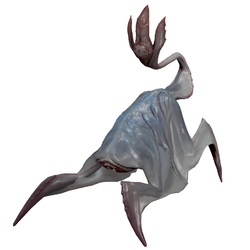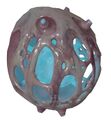Reviver
This article is a stub. Maybe you can help by expanding it. |
|---|
| This article would greatly benefit from the addition of one or more new images. | ||
|---|---|---|
Please upload one or several relevant images (from canonical / official sources) and place it here. Once finished, this notice may be removed. |

| |
| Reviver | |
|---|---|
| General information | |
| Type |
Headcrab variation |
| Personal information | |
| Attack(s) |
Ranged electric attack, revival of dead zombies. |
| Game information | |
| Entity |
npc_headcrab_runner |
| Designer(s) |
|
- "There was like a... dog-looking... lightning thing."
- ― Alyx Vance[src]
The Reviver, also called "lightning dog" by Alyx Vance, is a Headcrab variation previously unknown before the Combine invasion. It is only encountered in the chapter The Northern Star throughout the eponymous hotel.
Contents
Overview[edit]
Resembling a scorpion, the Reviver has a flattened blue body with loose skin that hangs between its limbs, a mouth lined with razor-edged teeth, and a long tail that terminates in three fins. A pulsing blue dot pattern glows through its skin on the top and underside of its body. The spherical organ at the end of its tail functions as its eye, the creature aiming its appendage towards what its facing while the eyeball darts around to scan the surroundings. On its own, it has the ability of shooting an electric ball which deals a small amount of damage and disables the indicators on the Gravity Gloves. Per its name, the Reviver can also enter the chest cavity of a dead zombie to reanimate the corpse, creating a Revived Zombie. The presence of a Reviver causes interference in Alyx's radio communications with Russell.
Upon death, the Reviver expels its heart which functions similarly to a Combine Battery, even being able to substitute in place of one.
Behavior and skills[edit]
Revivers are very skittish in nature. They prefer to wait and ambush prey, firing electrical balls from a distance to catch them unaware. When approached or hurt, they'll release a smokey electrical cloud to confuse their foe, and then either run away or pounce on their attacker. They're much more aggressive when inside a Revived Zombie. They'll lumber toward their attacker, trying to hurt them with the lightning they produce. They'll also produce long-range shocks that travel in straight lines across the floor. This change in behavior implies a somewhat symbiotic relationship with Headcrab Zombies, specifically a commensalistic one, as the Reviver does not lead to the death of Headcrab Zombie but nevertheless benefits from their death and the ability to repossess the host body.
Revivers appear to be territorial even to other members of their own species. Two can be seen growling at each other when Alyx approaches the top of the Northern Star. This is why rarely more than one is encountered at a time in the hotel. However, these two appear to put their differences aside when a more dangerous creature arrives in their domain, in this case, Alyx Vance.
After being critically injured and near death, Revivers will stop attacking and limp along the floor slowly while whimpering.
Behind the Scenes[edit]
The animations for the Reviver were originally seen as "cute" by playtesters, refusing to kill it to proceed and some even trying to pet it. This led to a redesign of its animations to be more unsettling and menacing and introducing more aggressive behavior, adding a jump attack if players got too close.[3]
Gallery[edit]
Pre-release[edit]
Concept art of Xen flora resembling the Reviver's electrical attack.
Retail[edit]
List of appearances[edit]
References[edit]
- ↑
 Tweet: "Concept Art for Reviver" @NaruOmori on Twitter (July 25, 2020)
Tweet: "Concept Art for Reviver" @NaruOmori on Twitter (July 25, 2020)
- ↑ Christine Phelan Creature Animation Reel 2020 on Vimeo (June 30, 2020)
- ↑ Half-Life: Alyx commentary









